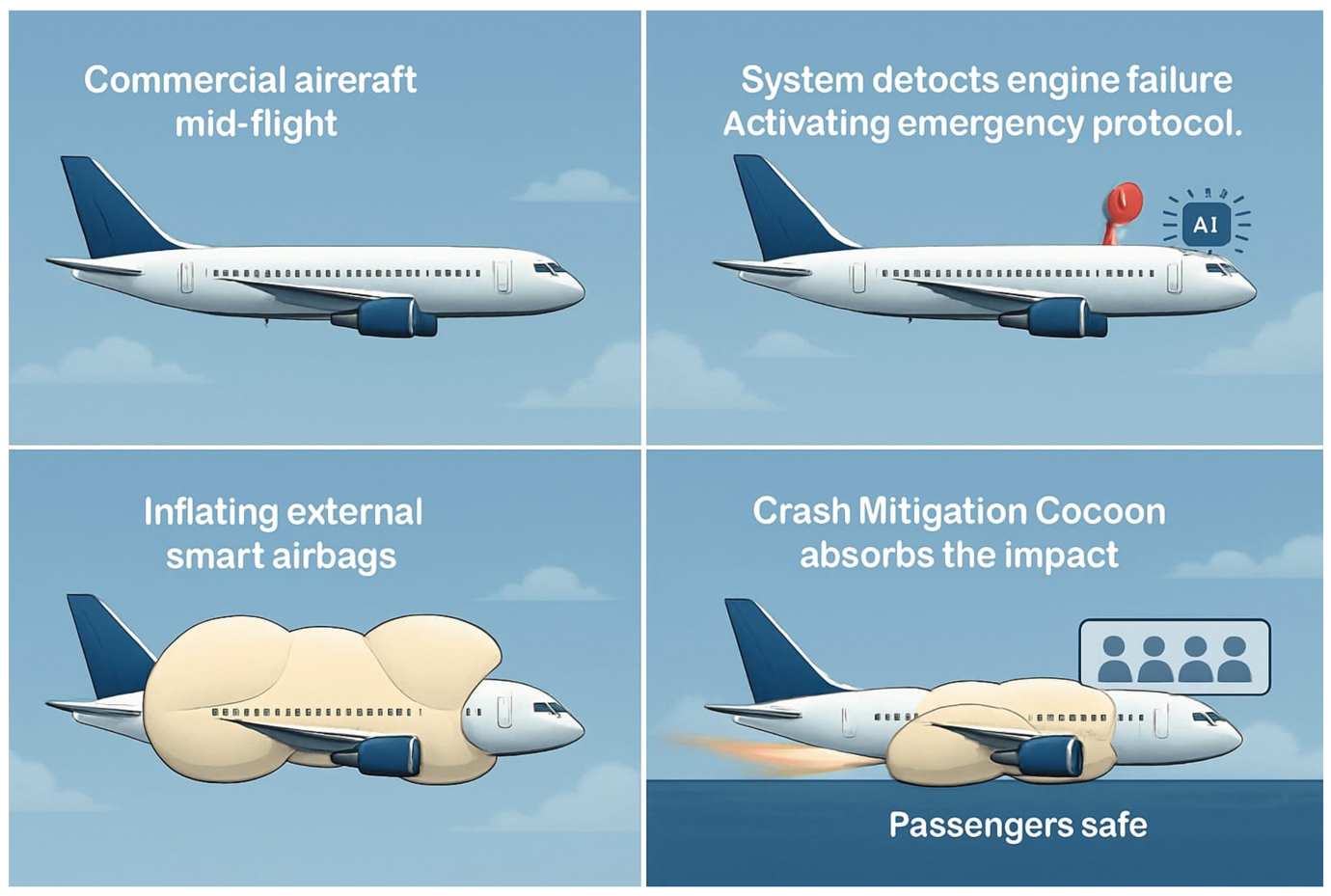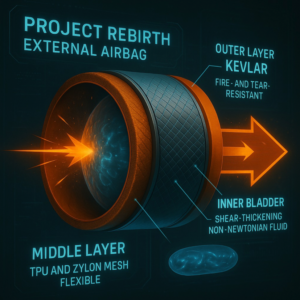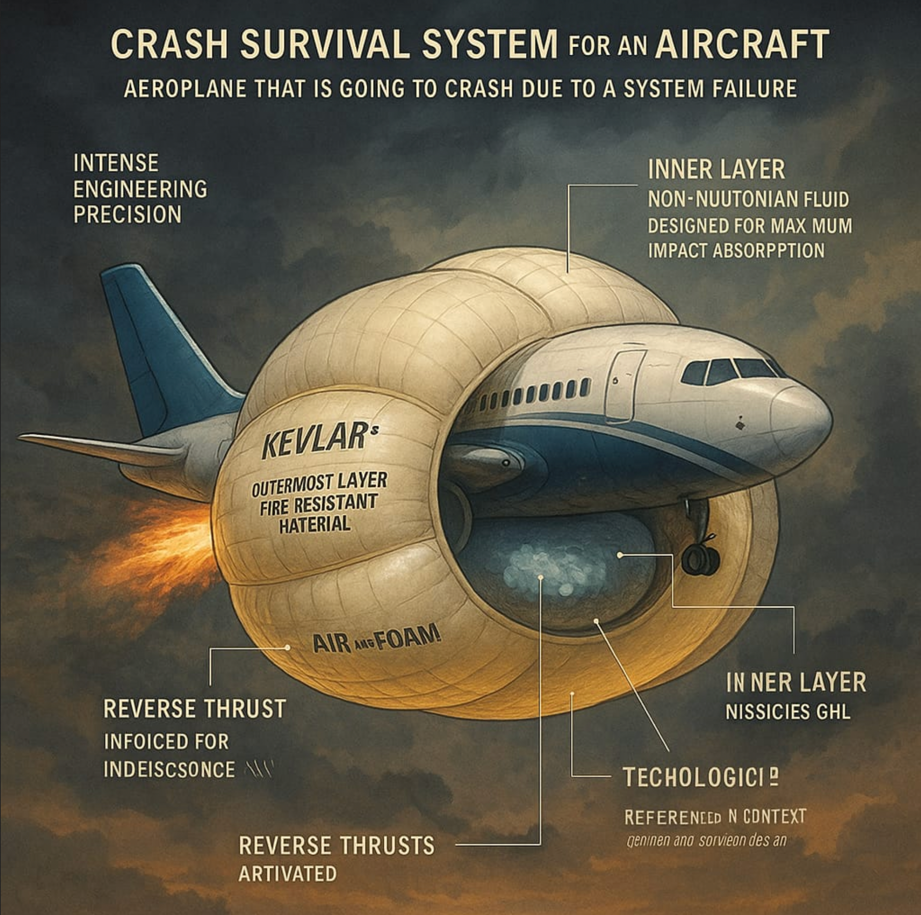© The James Dyson Foundation 2025
In recent weeks, a student-initiated initiative from Dubai has garnered significant attention in aviation and technology news. Project REBIRTH is an AI-driven crash-survival system designed to envelop an aeroplane in rapidly inflating exterior airbags, introduce “smart” impact-absorbing fluids, and utilise reverse thrust or gas thrusters to decelerate and stabilise a failing descent. The team, located at BITS Pilani, Dubai, has submitted the concept to the 2025 James Dyson Award competition, presenting it as a critical safety measure to transform deadly accidents into survivable landings.
Despite being in the conceptual phase, REBIRTH is remarkably detailed. The designers delineate an AI detection framework that supervises altitude, velocity, engine and system integrity, flight trajectory, potential onboard combustion, and pilot inputs. Should the system determine that a collision is inevitable—especially below approximately 3,000 feet, when alternatives are severely restricted—it would autonomously initiate a series of safety measures while allowing pilots the opportunity to override. This is presented not as a revolution in autonomy, but as a safety mechanism that activates when traditional airmanship and redundancy have been depleted.
The fundamental concept: procure survivability through temporal extension, resistance, and cushioning.
REBIRTH is founded on three principles: external airbags, impact-modulating materials, and reverse-thrust/auxiliary deceleration.
• External airbags would activate from the nose, belly, and tail, creating a high-velocity “crash pad” encircling the fuselage. In conceptual animations and renderings, the skin expands rapidly, redistributing loads from the stiff airframe and absorbing a substantial portion of kinetic energy upon touchdown. The objective is not to preserve the aeroplane but to sustain habitable space and safeguard humans from fatal deceleration and structural breaches.
Impact-absorbing fluids and intelligent liners—such as shear-thickening or non-Newtonian materials optimised for swift energy dissipation—would collaborate with airbags to mitigate the “crash pulse,” transforming a sudden spike in g-loads into a prolonged, survivable plateau. REBIRTH materials would be included into seats and internal panels to mitigate secondary injuries.

• Reverse thrust or gas thrusters would be utilised opportunistically. If engines maintain responsiveness, reverse thrust may provide drag prior to touchdown; if not, independent gas thrusters could stabilise attitude and reduce speed in the closing moments. This is a bold inclusion—reverse thrust during flight is often limited on transport jets—but the design regards it as a regulated, emergency measure rather than a standard operation.
The team asserts that preliminary simulations indicate a significant decrease in impact forces, with publicly cited values exceeding 60% reductions in certain virtual scenarios; however, these results have not yet undergone peer review and require thorough validation.

| Three categories of challenges are prominent:
1.Aerodynamics and structural cohesion. Externally housing big airbags without inducing parasitic drag during normal flight necessitates innovative packaging solutions. Deployment must be nearly instantaneous yet regulated, averting asymmetric inflation that could trigger a roll or pitch disturbance. The envelope must endure initial touch and then navigate irregular terrain or water without sustaining catastrophic tears. Incorporating hard-points into a pressurised fuselage—without incurring weight penalties that diminish payload and efficiency—will be a primary trade-off.
2. Dependability and false-positive mitigation. Airbags that deploy at inappropriate times would be intolerable. This advances the AI/avionics towards triple-modular redundancy, diverse sensors (e.g., radar altimeter, inertial state, optical terrain mapping), and stringent “arming” logic linked to altitude above terrain and rate-of-change criteria. This also prompts enquiries on maintenance: how can one identify a compromised cartridge or a micro-tear in a packed airbag prior to flight? These issues are solvable—automotive airbags, evacuation slides, and ram-air turbines establish precedents—but necessitate airline-grade reliability.
3. Operational compatibility. Utilising reverse propulsion during flight is prohibited for valid reasons: ingestion of debris, disruption of airflow over control surfaces, and increased structural loads. REBIRTH would require either engines specially authorised for limited reverse at certain speeds and attitudes or separate thrusters appropriately sized to assist without transforming the aeroplane into a rocket. Certification agencies would require comprehensive envelope safeguards.
| What history reveals regarding “last-resort” systems
Aviation has embraced certain contingency systems previously regarded as implausible. Evacuation slides and life rafts are now conventional, and Engineered Material Arresting Systems (EMAS) have mitigated aeroplane overruns that might have been more severe in previous decades. Ballistic recovery parachutes for light aircraft, once considered a curiosity, have proven to save lives. Each of these included packaging, weight, and maintenance expenses that the industry finally deemed acceptable. REBIRTH occupies a philosophical position within that family, albeit at the scale of transport planes and with somewhat higher energies. The impulse of the student creators—to incorporate a survivability “airbag” in aerial endeavours instead of depending exclusively on terrestrial mitigations—aligns with that tradition.

| The human element: psychology, training, and communication
Should it be accomplished, REBIRTH would moreover constitute a human-factors initiative. Pilots require unequivocal arming criteria, cockpit notifications, and procedures that ensure activation is predictable under duress. The cabin crew necessitates procedures for brace placements suitable for “soft-shell” contact and for post-impact egress when the fuselage is enveloped in fabric. Passengers require briefing cards that elucidate, without inducing anxiety, the concept of an external cocoon. The designers have indicated the inclusion of rescue beacons and post-crash communication to expedite response—prudent measures if the aircraft lands off-airport or in inhospitable terrain.We intend to construct functional prototypes of REBIRTH’s primary components—AI crash detection, airbags, intelligent seat liners, reverse thrust, and rescue signals. We will evaluate them in laboratories with specialists utilising wind tunnels and drop testing. We seek to collaborate with aircraft manufacturers, safety organisations, and governmental entities to obtain certification. REBIRTH is engineered for compatibility with older aircraft, enabling rapid installation by carriers. We will establish a firm to develop the concept, file patents, and secure support. “In five years, we aim for REBIRTH to be tested, approved, and implemented in actual flights—transforming crash survival from an anomaly into a standard,” states the Rebirth Project.

